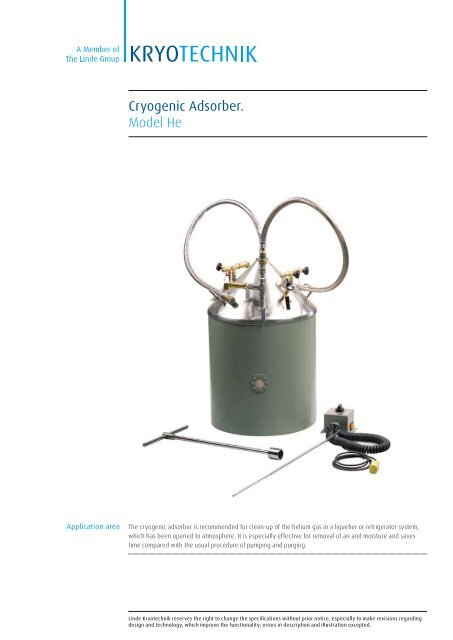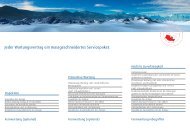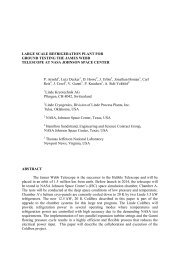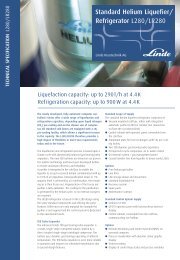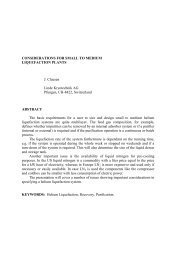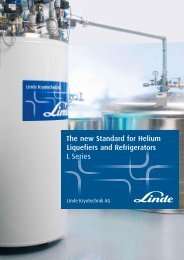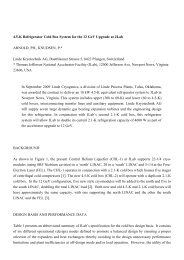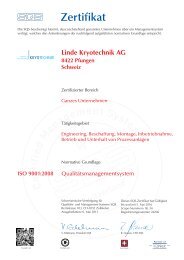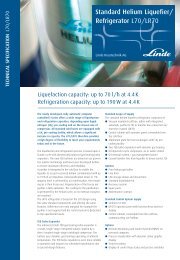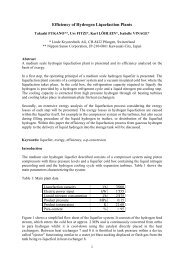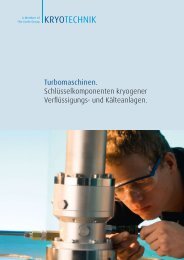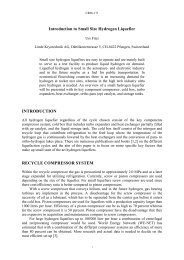Cryogenic Adsorber. Model He - bei Linde Kryotechnik AG, Schweiz
Cryogenic Adsorber. Model He - bei Linde Kryotechnik AG, Schweiz
Cryogenic Adsorber. Model He - bei Linde Kryotechnik AG, Schweiz
You also want an ePaper? Increase the reach of your titles
YUMPU automatically turns print PDFs into web optimized ePapers that Google loves.
<strong>Cryogenic</strong> <strong>Adsorber</strong>.<br />
<strong>Model</strong> <strong>He</strong><br />
Application area<br />
The cryogenic adsorber is recommended for clean-up of the helium gas in a liquefier or refrigerator system,<br />
which has been opened to atmosphere. It is especially effective for removal of air and moisture and saves<br />
time compared with the usual procedure of pumping and purging.<br />
<strong>Linde</strong> <strong>Kryotechnik</strong> reserves the right to change the specifications without prior notice, especially to make revisions regarding<br />
design and technology, which improve the functionality; errors in description and illustration excepted.
<strong>Linde</strong> <strong>Kryotechnik</strong> <strong>AG</strong>. <strong>Cryogenic</strong> <strong>Adsorber</strong> 2 of 2<br />
The most important requirement to obtain continuous operation of a liquefaction / refrigeration system<br />
over extended periods of time is the elimination of contaminants from the helium process stream within the<br />
system. While solid particles or dirt may plug the system or damage moving parts, gaseous contaminants that<br />
can condense and solidify at low temperature must also be removed. Gaseous contaminants could enter the<br />
system during installation or from helium gas replenishment sources. Contamination may also result from the<br />
introduction of air into the system through small leaks, especially when the system is <strong>bei</strong>ng operated at subatmospheric<br />
pressure.<br />
After the system has been decontaminated, the adsorber may serve an alternate purpose, which is to<br />
remove impurities from helium gas replenishment sources. The pure helium supply source or make-up gas<br />
is to be 99.995% pure; no more than 50 ppm (parts per million) impurities are allowed. However, since<br />
control between suppliers over the impurities is difficult, it is recommended that the gas be passed through a<br />
<strong>Cryogenic</strong> <strong>Adsorber</strong> before introducing it as pure make-up gas to the liquefier / refrigerator.<br />
Description<br />
1<br />
<strong>He</strong>lium Inlet<br />
5<br />
Powered Insulation<br />
2<br />
3<br />
<strong>He</strong>at Exchanger<br />
Activated Charcoal<br />
6<br />
Relief Valve,<br />
20.7 bar(g) (300 psi)<br />
4<br />
Liquid Nitrogen<br />
7<br />
<strong>He</strong>lium Outlet<br />
schematic drawing<br />
Gas enters the unit with 13 - 17 bar and passes through a heat<br />
exchanger, where it is cooled by the outlet gas stream. It then<br />
enters a stainless steel, liquid nitrogen cooled vessel, containing<br />
adsorbent material, where impurities are adsorbed.<br />
The stream continues through the heat exchanger to the outlet<br />
side of the unit. The addition of a liquid nitrogen level control<br />
permits unattended operation of the unit for extended periods.<br />
Periodically, the unit must be warmed up and regenerated.<br />
Duration<br />
The duty period before regeneration, which is required (four to eight hours), depends on the impurity level<br />
in the gas. Liquid nitrogen consumption is one liter per hour (static); two liters per hour (operating), 25 liters<br />
required to charge the system. The helium flow rate at 17 bar is 95 Nm 3 /h maximum with 2 bar pressure drop.<br />
The output gas has reduced impurity level of less than 5 ppm and a dew point less than 211 Kelvin (-62 °C).<br />
Duty period before regeneration<br />
Depends upon impurity level in gas<br />
Liquid Nitrogen consumption 1 l/h (static)<br />
Flow rate @ 17 bar (250 psi)<br />
Output prity<br />
2 l/h (operation)<br />
25 liters required to charge system<br />
95 Nm 3 /h (60 SCFM) maximum with<br />
2 bar (30 psi) pressure drop<br />
Reduces impurity level to less than 5 ppm and<br />
dew point to less than 211 Kelvin (-62 °C)<br />
<strong>Linde</strong> <strong>Kryotechnik</strong> <strong>AG</strong><br />
Daettlikonerstrasse 5, 8422 Pfungen, Switzerland<br />
Phone: +41.52.304-05 55, FAX: +41.52.304-05 50, www.linde-kryotechnik.ch, info@linde-kryotechnik.ch


